

Feudal Japan Sources. The Forty-seven Ronin: Japan’s National Legend. In Praise of Shadows: Ancient Japanese Aesthetics and Why Every Technology Is a Technology of Thought. The Samurai Archives Japanese History Page. Ancient Japan on Flipboard. eKokuhou - National museum possession National treasures Important cultural properties. Internet History Sourcebooks Project. East Asian History Sourcebook There is no way of avoiding the fact that China is the central culture of Eastern Asia.
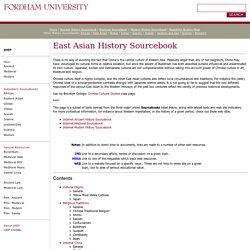
Massively larger than any of her neighbors, China may have developed its cultural forms in relative isolation, but since the advent of Buddhism has both absorbed outside influences and disseminated its own culture. Japanese, Korean and Vietnamese cultures are not comprehensible without taking into account power of Chinese culture in art, literature and religion.
Chinese culture itself is highly complex, and the other East Asian cultures also reflect local circumstances and traditions. For instance the (later) Chinese ideal of a scholar-gentleman contrasts strongly with Japanese warrior ideals. See my Brooklyn College: Chinese Cultural Studies class page. This page is a subset of texts derived from the three major online Sourcebooks listed below, along with added texts and web site indicators. Contents Cultural Origins General Yellow River Valley Cultures. Primary Sources with Document-based Questions. Millard Fillmore, 1800-1874; Matthew Perry, 1794-1858 • Commodore Perry and Japan (1853-1854) On July 8, 1853, Commodore Matthew Perry of the United States Navy, commanding a squadron of two steamers and two sailing vessels, sailed into Tôkyô harbor aboard the frigate Susquehanna and forced Japan to enter into trade with the United States.
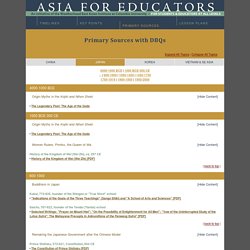
This unit examines that historical exchange with an introductory essay and an examination of the three letters that President Fillmore and Commodore Perry wrote to the Japanese emperor [PDF]. • Excerpts from the Letter from Emperor Meiji (Mutsuhito) to President Ulysses S. Feudal Japan Sources. Wabi-Sabi: A Short Film on the Beauty of Traditional Japan. We've featured the work of Spanish filmmaker Cristóbal Vila before: His short film "Inspirations" celebrated the mathematical art of M.C.

Escher. "Fallingwater" animated one of Frank Lloyd Wright's finest creations. And "Nature by Numbers" showed us geometrical and mathematical formulas found in nature. Today, we bring you Vila's latest "Wabi-Sabi: A Handful of Memories from Traditional Japan. " As he notes on his site, the animation captures the "aspects that interest me the most about traditional Japan," featuring "scenes inspired by nature, gardens, architecture, interior scenes, etc. " New Translation Of 450-Year-Old Book Written By Famous Samurai Reveals The Secret Lives Led By These Warriors. 25 Historical Facts About Japan. Wabi-Sabi: A Short Film on the Beauty of Traditional Japan. The Making of Japanese Handmade Paper: A Short Film Documents an 800-Year-Old Tradition. For many of us, washi paper is the art supply equivalent of a dish that's “too pretty to eat.”

I love to look at it, but would be loathe to mar its beauty with my amateur creative efforts. Originally intended for use in lanterns and shoji screens in Japan, its simplicity makes it a stand out among the far more ornamental decorative sheets populating the fancy international paper selections. Though there is no shortage of machine-produced washi on the market these days, the loveliest examples are still handmade in Kurotani, a small town near Kyoto. Kurotani has the distinction of being Japan’s oldest paper-making town, and as documented by filmmaker Kuroyanagi Takashi, above, the washi process has changed little in 800 years. In the pre-industrial age, washi-making was seasonal. Then as now, the resulting pulp was added mixed with liquid and a mucilage to yield a (not particularly delicious sounding, and definitely not too pretty to eat…) spreadable paste.
Ancient Samurai Scroll Describes Blinding Powders, Moonless Battles. An enigmatic samurai text known as the "Sword Scroll" has been translated into English for the first time, revealing instructions for successful nighttime battles and recipes for blinding powders.
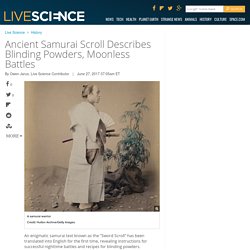
The text may have been written almost 500 years ago, though that date is uncertain. Attributed to two elite samurai, the text says that to be an effective sword fighter, one must have "no evil in your heart," and the spirit, eyes, hands and feet must all be in balance. Mashable. The Samurai. Internet History Sourcebooks Project.
East Asian History Sourcebook There is no way of avoiding the fact that China is the central culture of Eastern Asia.

Massively larger than any of her neighbors, China may have developed its cultural forms in relative isolation, but since the advent of Buddhism has both absorbed outside influences and disseminated its own culture. Japanese, Korean and Vietnamese cultures are not comprehensible without taking into account power of Chinese culture in art, literature and religion.
Chinese culture itself is highly complex, and the other East Asian cultures also reflect local circumstances and traditions. For instance the (later) Chinese ideal of a scholar-gentleman contrasts strongly with Japanese warrior ideals. See my Brooklyn College: Chinese Cultural Studies class page. This page is a subset of texts derived from the three major online Sourcebooks listed below, along with added texts and web site indicators. Contents Cultural Origins General Yellow River Valley Cultures. Culture of the Samurai - Google Arts & Culture. Shogun - Center for Japanese Studies - Japanese Language, Culture and Traditions. The traditional Japan is as far away of our imagination as is the distance that separates us from the Country of the Rising Sun.
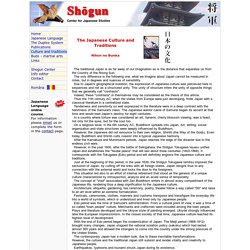
The only difference is the following one: what we imagine about Japan cannot be measured in miles, but in degrees and nuances of sensibility. Due to Japan's geographical isolation, the expression of Japanese culture was perceived here in sequences and not as a structured unity. This unity of structure infers the unity of opposite things that we generally call "contrasts". Indeed, these "contrasts" in themselves may be considered as the thesis of this article. Thus the 11th century AC, when the states from Europe were just developing, finds Japan with a classical literature in a centralized state.
Japanese history. The Samurai Archives Japanese History Page. Feudal Japanese Timeline. Japan: Memoirs of a Secret Empire . Enter Edo. After becoming supreme ruler in the late 16th century, Tokugawa Ieyasu moved Japan's capitol to Edo, (now known as Tokyo) transforming the sleepy fishing village into the country's premier political and economic center.

Shogun : Japan's Greatest Samurai Warrior (Full Documentary) BBC Warriors 2of6 Shogun 720p HDTV x264 AAC MVGroup org. Samurai, Daimyo, Matthew Perry, and Nationalism: Crash Course World History #34. Feudal Japan. Japan Under the Shoguns - Home. Timeline - Japan Under the Shoguns. Museum of the World. Isolated Japan Maps the Forbidden Outside World. For two centuries after 1640, the official Japanese policy towards the outside world was known as sakoku (‘closed country’), by which both Japanese leaving the country and foreigners entering it could expect the death penalty.
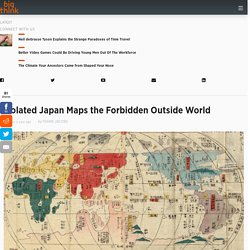
Although in practice not quite as harshly absolute as that, isolationism prevailed until American commodore Matthew Perry’s Black Fleet sailed into Uraga harbour in 1853, forcing Japan to open up, first to commerce with the U.S., later to trade with other western countries.